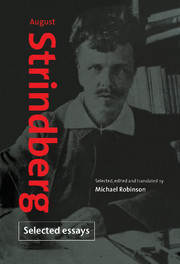Book contents
- Frontmatter
- Contents
- Notes on the text
- Introduction
- from Vivisections (1887)
- ‘On Modern Drama and Modern Theatre’ (1889)
- from Vivisections II (1894)
- ‘Césarine’ (1894)
- ‘Deranged Sensations’ (1894)
- ‘In the Cemetery’ (1896)
- from Jardin des Plantes (1896)
- ‘On the Action of Light in Photography’ (1896)
- ‘A Glance into Space’ (1896)
- ‘Edvard Munch's Exhibition’ (1896)
- ‘The Synthesis of Gold’ (1896)
- ‘Contemporary Gold-Making’ (1896)
- ‘The Sunflower’ (1896)
- ‘The Mysticism of World History’ (1903)
- ‘August Strindberg on Himself’ (1909)
- Notes and commentary
- Index
‘On the Action of Light in Photography’ (1896)
Published online by Cambridge University Press: 18 December 2009
- Frontmatter
- Contents
- Notes on the text
- Introduction
- from Vivisections (1887)
- ‘On Modern Drama and Modern Theatre’ (1889)
- from Vivisections II (1894)
- ‘Césarine’ (1894)
- ‘Deranged Sensations’ (1894)
- ‘In the Cemetery’ (1896)
- from Jardin des Plantes (1896)
- ‘On the Action of Light in Photography’ (1896)
- ‘A Glance into Space’ (1896)
- ‘Edvard Munch's Exhibition’ (1896)
- ‘The Synthesis of Gold’ (1896)
- ‘Contemporary Gold-Making’ (1896)
- ‘The Sunflower’ (1896)
- ‘The Mysticism of World History’ (1903)
- ‘August Strindberg on Himself’ (1909)
- Notes and commentary
- Index
Summary
How often have I not been surprised that light rays, which are said to be vibrations in the ether, cannot penetrate a door, while the notes of a piano, which are said to be merely air-waves, can penetrate a stone wall.
And this: in the upper atmosphere the sun and moon appear blood red, exactly as they do when rising or setting, when their rays have to penetrate denser gases, while sound concurrently decreases in strength, so that balloonists finally cannot hear one another's voices.
According to prevailing theories, the latter would mean that ether increases in thickness with height while air gets thinner. But this is again at variance with the first observation, namely that light waves do not pass through solid matter even though its every molecule, indeed its every atom, is thought to be surrounded by an atmosphere composed of ether.
During recent decades there has been a great deal of discussion about the unity of matter and the unity of forces, i.e. that light, heat and electricity are one and the same thing. But sound was always excluded. Light and sound remained discrete entities, and continued as such, among other things on these grounds, that light is transplanted through a vacuum, but sound is not. Matter was one and whole, but air and ether were still two, quite separate, and no one bothered to investigate what a vacuum was or what air was. Ether was an hypothesis, as everyone agreed, and hence inaccessible to analysis and synthesis.
- Type
- Chapter
- Information
- August Strindberg: Selected Essays , pp. 160 - 164Publisher: Cambridge University PressPrint publication year: 1996



